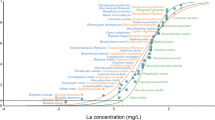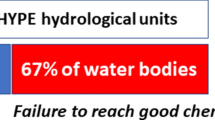Abstract
Common ions in effluents can be toxic to aquatic organisms over a wide range of salinities. Although the toxicity of high salinity (hypersaline) solutions and low salinity (hyposaline) solutions may be due to osmotic conditions, toxicity may also be the result of specific ion concentrations. Therefore, even in effluents of normal freshwater or marine salinity, common ion toxicity to aquatic organisms may occur in the absence of other toxicants. Little historical data exist on the toxicity of specific ions to freshwater or marine test organisms. Because of the paucity of data on the toxicity of common ions in produced waters, the Gas Research Institute (GRI) sponsored a research program to examine the toxicity of major ions to aquatic test organisms. The goal of this research is to quantify the relationships between common ion concentrations and organism response (mortality), and then to use these empirical relationships to develop models that would allow the prediction of organism response based upon known ion concentrations.
Access this chapter
Tax calculation will be finalised at checkout
Purchases are for personal use only
Preview
Unable to display preview. Download preview PDF.
Similar content being viewed by others
References
APHA, 1989. Standard methods for the examination of water and wastewater. American Public Health Association, Washington, DC.
Brown, R., 1991. All peaks aren’t Gausian. Personal Engineer. & Instrument. News, pp. 51–54, July.
Callahan, E., 1995. Estimating dose-response curves when organisms respond at both high and low doses, (paper in preparation).
Fillo, J. P., Hamaker, T. A., Koraido, S. M., Stefenacci, R. G., Tallon, J. T., Wesolowski, D., 1987. Production waters associated with the production, processing, transmission, and storage of natural gas: a literature survey. Gas Research Institute, Chicago, Illinois, GRI-87/0126.
Gulley, D. D., Mount, D. R., Hockett, J. R., Bergman, H. L., 1992. A statistical model to predict toxicity of saline produced waters to freshwater organisms, pp. 89–96, In: Ray, J. P., Engelhardt, F. R. (Eds.), Produced Water Technological/Environmental Issues and Solutions. Plenum Press, New York.
Hosmer, D. W., Lemeshow, S., 1989. Applied logistic regression, John Wiley & Sons, New York. 307 pp.
Mount, D. R., Gulley, D., 1992. Development of a salinity toxicity relationship to predict acute toxicity of saline waters to freshwater organisms. Gas Research Institute, Chicago, Illinois, GRI-92/0301.
Oddo, J. E., Tomson, M. B., 1994. Why scale forms and how to predict it. SPE Production and Facilities, SPE 21710:47–54.
O’Neil, P. E., harris, S. C., Mettee, M. F., Drottar, K. R., Mount, D. R., Fillo, J. P., 1989. Biomonitoring of a produced water discharge from Cedar Cover Degasification Field, Alabama. Gas Research Institute, Chicago, Illinois, GRI-89/0073.
Simmons, B. F., 1992. Treatment and disposal of wastewaters produced with coalbed methane by reverse osmosis, pp. 593–604, In: Ray, J. P., Engelhardt, F. R. (Eds.), Produced Water Technological/Environmental Issues and Solutions. Plenum Press, New York
Tibbetts, P. J. C., Buchanan, I. T., Gawel, L. J., Large, R., 1992. A comprehensive determination of produced water composition, pp. 97–112, In: Ray, J. P., Engelhardt, R R. (Eds.), Produced Water Technological/Environmental Issues and Solutions. Plenum Press, New York.
Tietge, J. E., Hockett, J. R., Evans, J. M., 1995. Discrimination of ion toxicity to six produced waters using the freshwater salinity toxicity relationships and TIE procedures. Society of Petroleum Engineers, SPE 2970, PP. 393–402.
USEPA., 1991. Methods for aquatic toxicity identification evaluations: phase I toxicity characterization procedures. United States Environmental Protection Agency, EPA/600/6–91/003.
Weber, C. I., (Ed.), 1993. Methods for measuring the acute toxicity of effluents and receiving waters to freshwater and marine organisms. United States Environmental Protection Agency, EPA/600/4–90/027F.
Wesolowski, D., Broughton, A., Hansotte, C. A., Koraido, S. M., Fillo, J. P., 1987. Characterization of produced waters from natural gas production operations. Gas Research Institute, Chicago, Illinois, GRI-87/0335.1.
Author information
Authors and Affiliations
Editor information
Editors and Affiliations
Rights and permissions
Copyright information
© 1996 Plenum Press, New York
About this chapter
Cite this chapter
Pillard, D.A., Tietge, J.E., Evans, J.M. (1996). Estimating the Acute Toxicity of Produced Waters to Marine Organisms Using Predictive Toxicity Models. In: Reed, M., Johnsen, S. (eds) Produced Water 2. Environmental Science Research, vol 52. Springer, Boston, MA. https://doi.org/10.1007/978-1-4613-0379-4_6
Download citation
DOI: https://doi.org/10.1007/978-1-4613-0379-4_6
Publisher Name: Springer, Boston, MA
Print ISBN: 978-1-4613-8025-2
Online ISBN: 978-1-4613-0379-4
eBook Packages: Springer Book Archive




